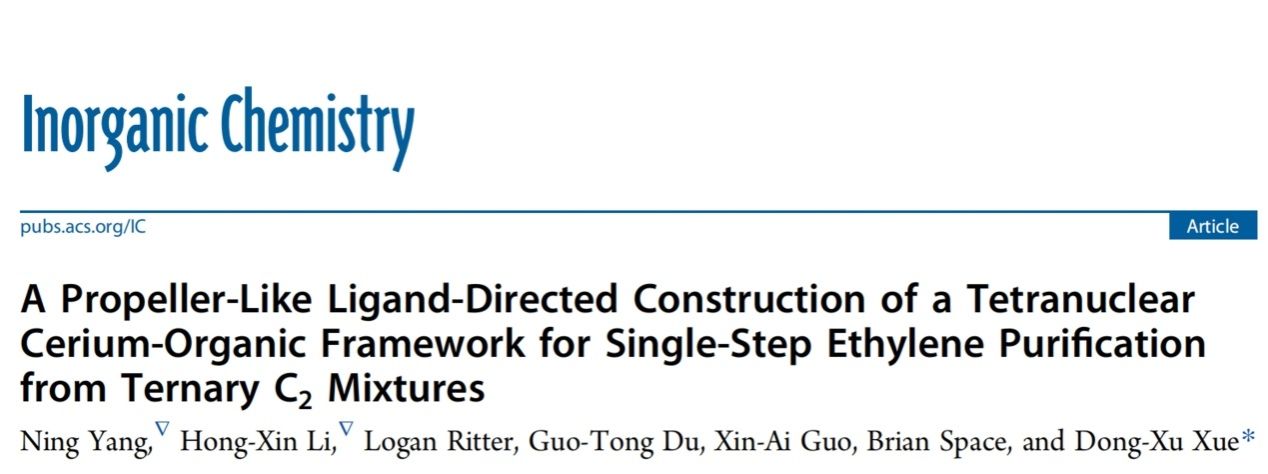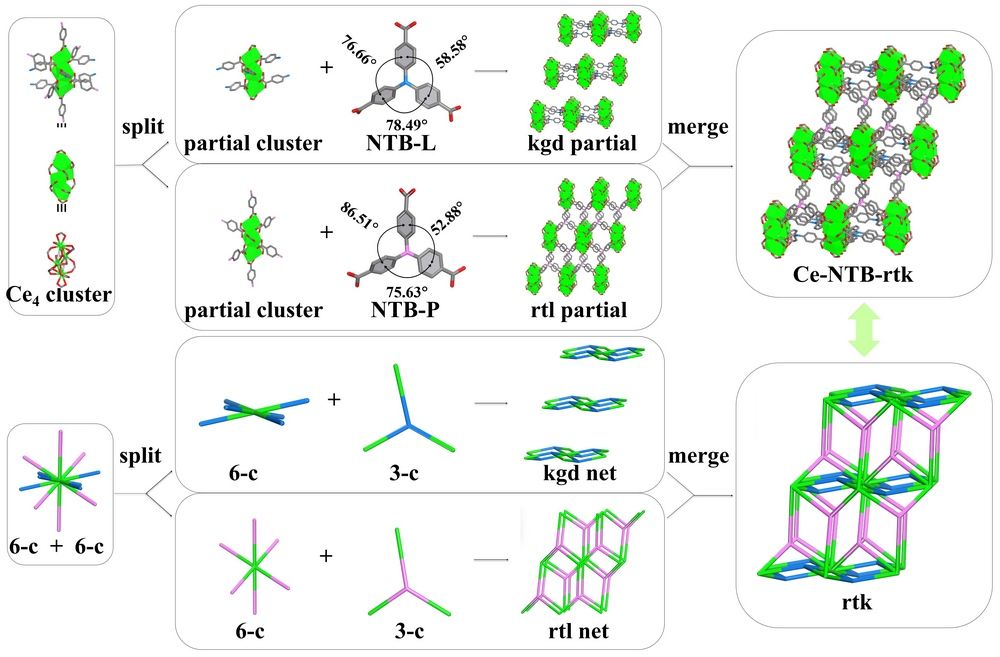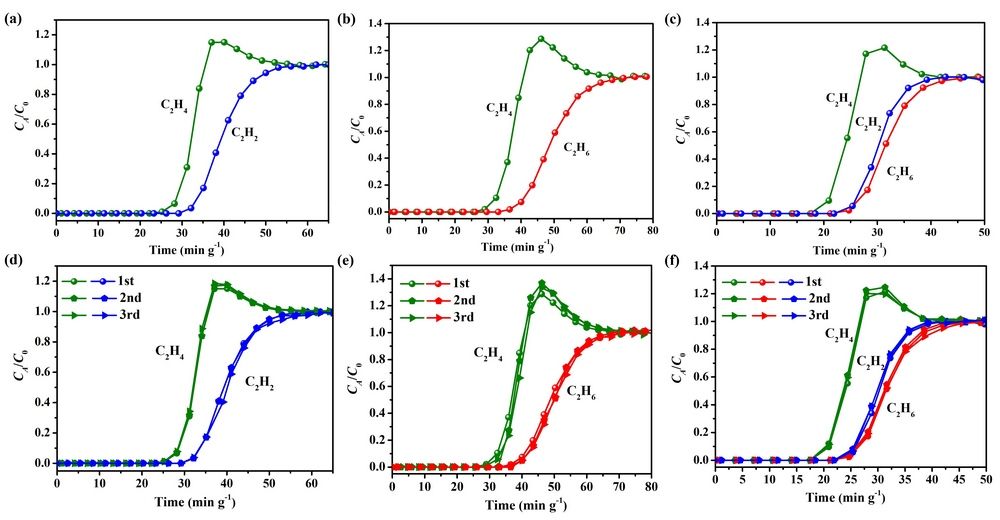

Ning Yang#, Hong-Xin Li#, Logan Ritter, Guo-Tong Du, Xin-Ai Guo, Brian Space, Dong-Xu Xue*. Inorg. Chem. 2024, DOI: 10.1021/acs.inorgchem.4c02473
Ethylene (C2H4), a cornerstone in the pantheon of petrochemical products, is instrumental in the synthesis of a plethora of valuable organic compounds and polymers. The impurities of ethane and acetylene in ethylene products can´t meet the requirements of industrial use. The traditional method of obtaining high purity ethylene has high energy consumption and high cost, which hinders its practical application. Therefore, it is of great significance to find a low cost and high efficiency ethylene separation technology.

Figure 1. Schematic representation showing the assembly of Ce-NTB-rtk. Top: the frameworks of kgd and rtl are split and then merged to form Ce-NTB-rtk; bottom: kgd and rtl nets are merged to form rtk network. Ce = green, C = gray, N = blue/pink, O = red and F = cyan. Hydrogen atoms and the terminally coordinated methanol molecules are omitted for clarity.
Metal-organic frameworks (MOFs), a new class of crystalline porous materials renowned for their tunable pore sizes, diverse chemical functionalities, and high surface areas. Adsorptive purification technology based MOFs, with its potential for energy efficiency and operational cost reduction, has been hailed as a promising avenue for the future of gas separation. While MOFs have been explored for the separation of binary mixtures such as C2H2/C2H4 or C2H6/C2H4, respectively, the simultaneous removal of C2H2 and C2H6 from a ternary mixture is a more complex and challenging task. This is largely due to the intermediate quadrupole moment and polarizability of C2H4, which fall between those of C2H2 and C2H6, making it difficult to simultaneously remove C2H2 and C2H6 in a single step. Although a few MOF materials have been reported to enable single-step purification of ethylene from a ternary C2 mixture, the design and synthesis of such materials remains a pressing need and a formidable challenge.

Figure 2. Experimental column breakthrough curves for (a) C2H2/C2H4/He (25/25/50) mixture under a flow of 2 mL min-1, (b) C2H6/C2H4/He (25/25/50) mixtures under a flow of 2 mL min-1 and (c) C2H2/C2H4/C2H6/He (16.5/16.5/16.5/50) mixture under a flow of 1.2 mL min-1 in an absorber bed packed with Ce-NTB-rtk at 298 K and 1.0 bar. (d), (e) and (f) are their regenerative tests, respectively.
In our recent work, we have focused on the development of innovative MOFs through a ligand-conformer strategy. By utilizing amide or imine inserted tritopic carboxylate ligands, novel three-way rod and multi-cage zirconium-based MOFs have been successfully constructed. Additionally, cerium, a non-toxic, cost-effective, and abundant metal element, has been less explored in the construction of new MOFs compared to other rare-earth metals. Most cerium-based MOFs reported in the literature are structured from rod inorganic building units, while cluster-based cerium MOFs are relatively scarce. This presents an opportunity to expand the scope of cerium-based materials and to investigate their potential in various applications.

Figure 3. Preferential (a) C2H2, (b) C2H4, and (c) C2H6 molecule binding sites within Ce-NTB-rtk simulated with GCMC.
Building on above considerations, we have introduced a propeller-like ligand as the connecting node and utilized cerium as the metal source to construct a new cerium-based MOF material, i.e., Ce-NTB-rtk. In this structure, in situ generate a rare tetranuclear cerium cluster of [Ce4F2(O2C-)12], such cluster is observed for cerium ion for the first time, which is further connected via NTB linkers in a mode of μ5-η2:η1:η1:η2:η1. Topological analysis reveal that it is a new (3,3,12)-c net. Considering the occurrence of two crystallographically independent NTB linkers (i.e., ligand conformer) within Ce-NTB-rtk, such (3,3,12)-c framework can be split into a 2D (3,6)-c kgd net and a 3D (3,6)-c rtl one, consequently resulting in a merged (3,3,12)-c rtk network. The results of low-pressure gas adsorption isotherms, IAST selectivity and adsorption enthalpy data indicate that Ce-NTB-rtk has the potential to purify ethylene from ternary C2 gas in one step, which is further verified by breakthrough test and GCMC theoretical calculation. The good separation performance of Ce-NTB-rtk is mainly due to its suitable microporous cavity and nonpolar microenvironment. This discovery further illuminates the efficacy of the ligand-conformer approach in the synthesis of novel metal clusters and the subsequent creation of porous frameworks, paving the way for their application in cutting-edge technologies.
First Authors: Ying Ning, master’s candidate, Li Hongxin, doctoral candidate, Shaanxi Normal University
Correspondence Author: Prof. Xue Dongxu, Shaanxi Normal University
Full Text Link: https://pubs.acs.org/doi/10.1021/acs.inorgchem.4c02473
 Latest Updates
Latest Updates






